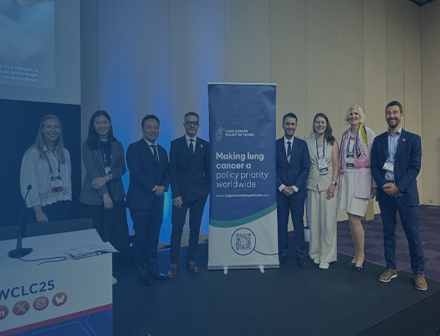Understanding air pollution
Addressing air pollution provides an opportunity to examine a causal factor of many conditions – specifically respiratory diseases – and take a preventive approach. Without this shift in mindset, our ability to achieve global non-communicable disease reduction targets is severely limited.
Air quality around the world is deteriorating as the use of industrial processes and fossil fuels rises. This deterioration has been exacerbated by an increase in air pollution caused by natural disasters such as wildfires – a symptom of climate change. In 2022, every day, 99% of the world’s population inhaled outdoor air that exceeded WHO guideline limits on air pollution.
Awareness of the negative impact of air pollution, and direct action to reduce exposure to it, could have a positive impact on lung health.
The impact of air pollution on lung health
Air pollution is a leading risk factor for lung and respiratory disease, including lung cancer: 4.3 million deaths are caused each year from exposure to household (indoor) air pollution, and 3.7 million deaths from ambient (outdoor) air pollution. Other important risk factors include smoking and occupational exposure to airborne hazards. Globally, ambient air pollution is estimated to cause:
- 29% of deaths from lung cancer
- 43% of deaths from chronic obstructive pulmonary disease (COPD)
- 25% of deaths from ischaemic heart disease
- 24% of deaths from stroke.
As air quality is predicted to worsen, its negative impact on health will likely be more acutely felt than ever before.
The role of air pollution on widening health inequalities
The impacts of air pollution are unevenly felt: it particularly affects women, children and older people, and can more adversely affect people of lower socioeconomic position.
Deaths related to ambient air pollution are greater in low- and middle-income countries (where they represent 8.7% of total deaths) than in high-income countries (4.3% of deaths).
Low-income populations are also more likely to be exposed to high levels of outdoor and indoor air pollution; they often live in the most polluted areas of cities and are more likely to experience indoor air pollution from cooking and heating.
Two billion children globally are exposed to polluted air exceeding WHO standards. Their lifelong consequences of air pollution exposure translate into long-term morbidity and higher health system costs. For example, exposure to air pollution may increase the risk of the development (or exacerbation) of asthma in children. Additionally, indoor air pollution has been identified as the cause of up to half of deaths due to acute lower respiratory infections in children under five.
What can be done to address air pollution from a health perspective?
To significantly reduce the impact of air pollution on lung health, interdisciplinary collaboration is needed. The World Health Assembly in 2015 highlighted that national decision-makers needed to:
- take WHO air quality guidelines into account
- collaborate with regional and international organisations to promote access to adequate technical and financial resources to improve air quality
- encourage health systems, including health protection authorities, to take a leading role in raising awareness among the public and all stakeholders of the impact of air pollution on health, and of opportunities to reduce or avoid exposure.
There has been some progress; in Europe, a new Ambient Air Quality Directive aims to achieve zero air pollution by 2050. However, air pollution remains the largest environmental health risk in the world.
As part of the lung cancer, respiratory and wider health community, the Lung Cancer Policy Network is committed to highlighting the impact of air pollution on respiratory health – specifically the prevalence of lung cancer. We encourage regional, national and international decision-makers to take action in prioritising improvements in air quality to help reduce the risk of lung cancer.
Recent news
Blog

Insights from WCLC 2025
At the World Conference on Lung Cancer in Barcelona, the Network hosted a very well-attended panel discussion focusing on the latest developments in lung cancer policy.
Case study

The screening programme for lung cancer in the Canadian province of British Columbia
We explore how a regional screening programme has been established throughout British Columbia.
News

Event to address lung cancer screening implementation in Central and Eastern Europe
On 16 September, the Network and the Croatian National Lung Cancer Screening Program will be hosting an in-person event.
